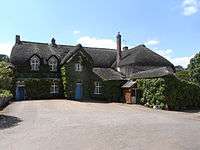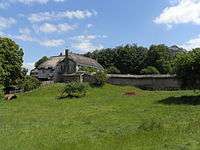Spencer Combe



Spencer Combe in the parish of Crediton, Devon, is an historic estate. The grade II listed farmhouse known today as "Spence Combe",[2] the remnant of a former mansion house, is situated 3 miles north-west of the town of Crediton. Spencer Combe is given in several traditional historical sources as the seat of Sir Robert Spencer (d.pre-1510) who married Eleanor Beaufort (1431–1501), the daughter of Edmund Beaufort, 2nd Duke of Somerset (1406–1455), KG, and who was father to two daughters and co-heiresses who made notable marriages. The arms of this Sir Robert Spencer were Sable, two bars nebuly ermine,[3] as shown in the Percy window in the chapel of Petworth House and as quartered by Cary, Viscount Falkland.[4] The American genealogist Douglas Richardson[5] suggests however that Sir Robert Spencer was in fact the son and heir of John Spencer, Esquire, MP for Dorset, of Frampton in Dorset, Ashbury in Devon and Brompton Ralph in Somerset, by his wife Jone. The arms given by Pole for Spencer of Spencer Combe, are: Argent, on a bend sable two pairs of keys or,[6] and are shown quartered by Prideaux on the monument in Farway Church, Devon, to Sir Edmund Prideaux, 1st Baronet (d.1628) of Netherton Hall, and are shown in stained glass impaled by de Esse of Thuborough in the Thuborough Chapel of Sutcombe Church.
Descent
Lancells
The earliest holder of the estate as recorded by the Devon historian Tristram Risdon (d.1640) was the Lancells family.[7] However the Devon historian Sir William Pole (d.1635) stated Comb Lancelles to be a separate estate to Cumbe, held by the Hody then Spencer families. Indeed, the grade II listed farmhouse[8] known today as "Combe Lancey" survives, situated within the parish of Sandford, to the immediate north-west of Crediton. Pole gave the descent of Comb Lancelles as follows:[9]
- Joce de Lancelles, who inherited Combe during the reign of King Henry III (1216-1272). In 1295 Joceus Lancelles was recorded as holding Combe and Sakington from the feudal barony of Bradninch as 1/8th of a knight's fee and in 1314 Joceus de Lancelles held from the feudal barony of Bradninch as 1/4 of a knight's fee the manors of Sakamenton, Combe, Dowrish, Ashridge and Blakannescombe.
- Hugh Lancelles held Combe in 1345.
Hody
Combe passed by inheritance to the Hody family.[10]
- William Hody, tempore King Richard II (1377-1399),[11] whose daughter Alice Hody, heiress of Combe, was the wife of Richard Spencer.
Spencer
On inheritance by the Spencer family the manor became known as Spencer Combe[12] or Spencer's Combe.[13] The arms of Spencer of Spencer Combe were given by Pole as: Argent, on a bend sable (or azure) two pairs of keys or,[14] and were later quartered by Prideaux, as visible in Farway Church (Prideaux of Netherton) and in Sutcombe Church, in the Thuborough Chapel. The descent is given by Pole as follows:
- Richard Spencer, who married Alice Hody, heiress of Combe.
- Thomas Spencer (son)
- John Spencer (son), who died without male progeny leaving as his sole heiress his daughter Jone Spencer, wife of Stephen Giffard of Thuborough in the parish of Sutcombe, Devon.
Giffard
- Stephen Giffard (fl. 1438,[15] of Thuborough, who inherited Spencer Combe on his first marriage to Jone Spencer, by whom he left a daughter Alice Giffard, heiress of Combe. He married secondly to Agnes Churchill, daughter and heiress of John Churchill of Wildyard, by whom he had a further two daughters and co-heiresses, Eleanor Giffard, wife of John Dennis of Orleigh and Mariote Giffard, wife of William Calmady (fl. 1458) of Calmady in the parish of Poundstock, Cornwall.[16]
- Alice Giffard, eldest daughter and heiress of Spencer Combe and Thuborough, who married thrice:[17]
Prideaux
- William Prideaux of Adeston in the parish of Holbeton, Devon, Escheator of Cornwall in 1461,[20] who married Alice Giffard, heiress of Spencer Combe. He abandoned his old seat of Adeston and made Thuborough his new seat.[21]
- Fulke Prideaux (1472-1531), eldest son and heir, who married as his second wife Katherine Poyntz, daughter of Sir Humphrey Poyntz of Langley in the parish of Yarnscombe, Devon.
- Humphrey Prideaux (1487-1550), son and heir by his father's second wife Katherine Poyntz, who married firstly Joane Fowell daughter of Richard Fowell of Fowellscombe, Devon, and secondly to Edith Hatch, daughter of William Hatch of North Aller in the parish of South Molton, Devon.
- Richard Prideaux (d.1603), eldest son and heir, of Thuborough, who married Katherine Arundell, a daughter of Sir John IV Arundell (1495–1561) of Trerice in Cornwall, known as Jack of Tilbury, an Esquire of the Body to King Henry VIII whom he served as Vice-Admiral of the West. Katherine's mother was Mary Bevill, daughter and heiress of John Bevill of Gwarnick, Cornwall and heiress to her nephew John Arundell of Gwarnick.
- Humphry Prideaux (d.1603/4), a younger son, to whom was given Spencer Combe by his father.[22] He was a Councellor at Law, seated at Westwood near Crediton.[23] He married Johanna Bevill (d.1612/13), daughter of John Bevill of Kelligarth, Cornwall.
- Beville Prideaux, son, who married a certain Margaret, the widow of George Leach (1602-pre-1637), 4th son of Sir Simon Leach (1567-1638) of Cadeleigh, near Crediton, Sheriff of Devon in 1624,[24] whose surviving monument in Cadeleigh Church is the largest of its type in Devon.[25] Beville Prideaux sold Spencer Combe to Sir Simon Leach.[26]
Leach
Sir Simon Leach (1567-1638) of Cadeleigh, near Crediton, Sheriff of Devon in 1624, purchased Spencer Combe from Beville Prideaux.[27]
References
- ↑ Debrett's Peerage, 1968, p.438, Viscount Falkland
- ↑ Listed building text
- ↑ Debrett's Peerage, 1968, p.438, Viscount Falkland
- ↑ Debrett's Peerage, 1968, p.438, Viscount Falkland
- ↑ Richardson, Douglas, Plantagenet Ancestry: A Study in Colonial and Medieval Families, Baltimore, Maryland, Genealogical Publishing Co, 2004, p.480, pedigree of Carey
- ↑ Pole, p.502
- ↑ Risdon, Tristram (d.1640), Survey of Devon, 1811 edition, London, 1811, with 1810 Additions, p.100
- ↑ Listed building text
- ↑ Pole, Sir William (d.1635), Collections Towards a Description of the County of Devon, Sir John-William de la Pole (ed.), London, 1791, p.227
- ↑ Risdon, p.100
- ↑ Pole, p.227
- ↑ Risdon, p.100
- ↑ Pole, p.227
- ↑ Pole, p.502
- ↑ Vivian, Lt.Col. J.L., (Ed.) The Visitations of the County of Devon: Comprising the Heralds' Visitations of 1531, 1564 & 1620, Exeter, 1895, p.397, pedigree of Giffard
- ↑ Vivian, p.128
- ↑ Vivian, p.397
- ↑ Vivian, p.618
- ↑ Vivian, Heraldic Visitations of Devon, p. 616
- ↑ Vivian, p.618
- ↑ Risdon, p.249
- ↑ Pole, p.227
- ↑ Vivian, p.619
- ↑ Vivian, p.526, pedigree of Leach
- ↑ Pevsner, Nikolaus & Cherry, Bridget, The Buildings of England: Devon, London, 2004, p.241
- ↑ Pole, p.227
- ↑ Pole, p.227